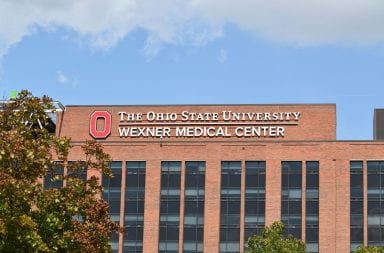The Ohio State slogan, “Do something great,” extends beyond students and applies to faculty as well.
In the last six months, the OSU Medical Center has surpassed $100 million in research funding. The effort of many OSU faculty members has made the large sum of funds possible.
“What has changed at Ohio State, at least in terms of biomedical research, is setting higher expectations of the faculty,” said Caroline Whitacre, associate vice president for health sciences research and vice dean for research in the College of Medicine and Public Health. “We want to increase our national ranking, and the best way to do that is to increase our research funding.”
Whitacre said the amount of research funding has been rising for the last several years.
“At the end of the fiscal year 2000, we were at $61 million in total research funding. By the end of 2001, we were at $71 million and by the end of the 2002 fiscal year, we were at $91 million,” Whitacre said.
The fiscal year ends in June of the calendar year. Between June and September, OSU passed the $100 million mark.
Brad Moore, vice president for research at the university, said the funding for research has been based on specific proposals by faculty members.
There are numerous exciting research projects going on, he said.
“One particularly nice example is the research of Dr. Lonnie Thompson and his wife, Dr. Ellen Mosely Thompson,” Moore said. “They go to the tops of tropical mountains and drill holes in the glaciers at the mountain tops. They use the cores of those to understand the climate on the top of that mountain for thousands of years.”
The researchers have won various prodigious awards and have been on CNN, he said.
“They’re our most famous researchers,” Moore said.
The Comprehensive Cancer Center of The Arthur G. James Cancer Hospital and Research Institute has applied and received funding for one of its project.
“The project involves faculty members from seven colleges and 15 departments. Over 200 faculty members are involved,” Moore said. “There’s lots of faculty working together from different fields, bringing their expertise together to work on cancer.”
Peter Hoftiezer, a junior in molecular genetics and a medical center lab technician, said it is important for OSU to continue its pursuit of raising more research funding.
“The fact that OSU has received so much funding is exciting. It allows the hospital to research new treatments for patients and allows the students to learn about those new treatments that are on the cutting edge of medicine,” Hoftiezer said.
Researchers are applying to several organizations for funding.
The National Institute of Health is the organization that contributes the greatest amount of research funding, Whitacre said.
“Researchers write grants about important topics in their field and then apply to the NIH. Then those are voted on by their peers who decide which have the most merit,” Whitacre said. “Right now, about 25 percent of the grants submitted receive funding.”
The decision of whether a grant receives funding depends on the experience of the lead investigator and their track record, she said.
Other important factors that are being considered are the quantity and quality of other proposals.
The National Science Foundation, Department of Defense, Department of Energy and the United States Army, as well as private corporations also provide OSU with funding.
“There has been a move by Congress over the last five years to double the NIH budget,” Whitacre said.
The budget for next year has not been unveiled at this time.


